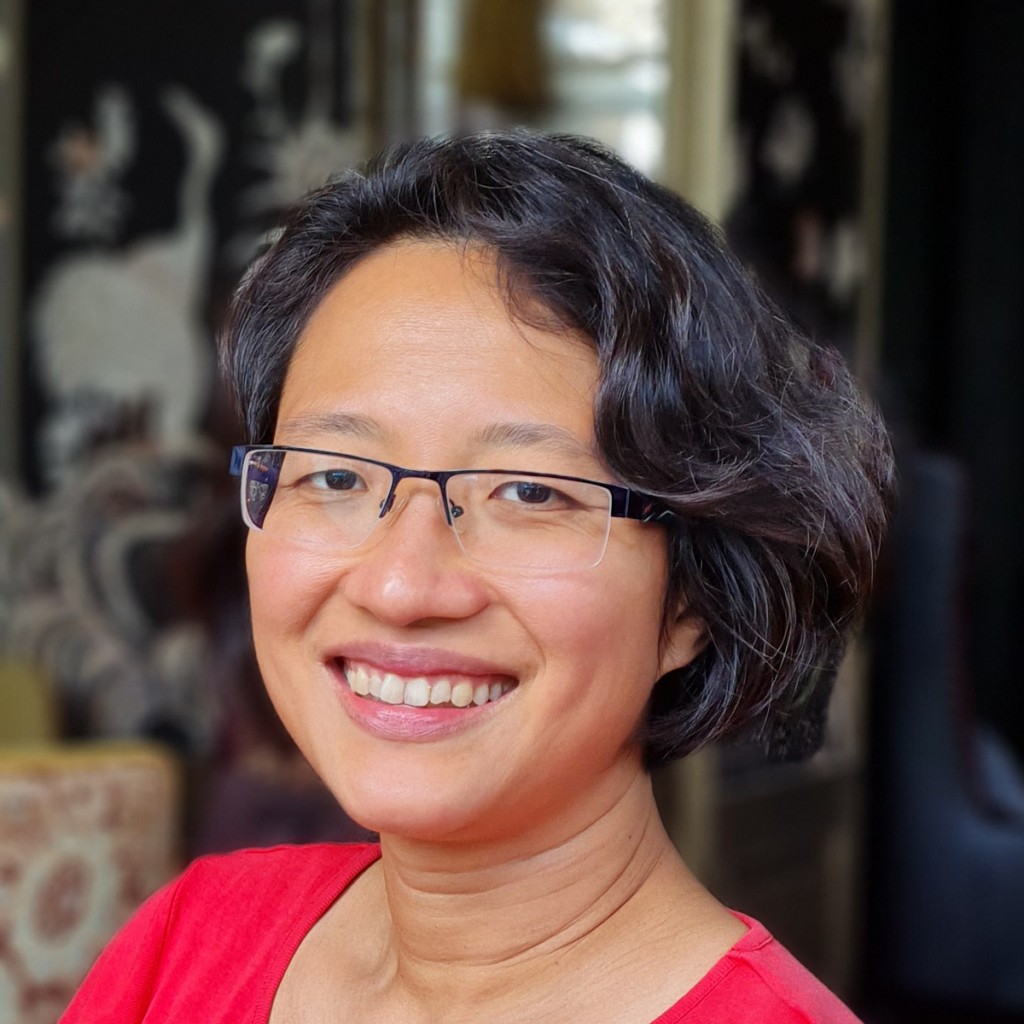Charis Quay Huei Li
maître de conférences* in Physics
Université Paris-Saclay

Charis Quay has been maître de conferences at the Université Paris-Saclay, and a member of the Nanostructures at the Nanosecond timescale (NS2) group at the Laboratoire de Physique des Solides (LPS), since 2010, following a postdoc at the CEA Saclay. Her interests lie at the intersection of spin(-orbit) physics and mesoscopic superconductivity, and she has worked on multifarious hybrid nanostructures ranging from cleaved-edge-overgrowth GaAs quasi-1D hole wires, metal spin valves and tunnel junctions, to carbon nanotube- and transition metal dichalcogenide (TMD)-based devices. In 2017, she was awarded a CNRS Bronze Medal for her work on non-equilibrium quasiparticle spins in mesoscopic superconductors: demonstration of spin-charge separation and spin resonance, and (later) evidence for spin-dependent heat transport. More recently, she has begun to study superconductors with strong spin-orbit coupling, with the goal of manipulating the spin degree of freedom of the superconducting condensate. A native of Ayer Tawar (Perak), Charis Quay received her BA* from Mount Holyoke College (Massachusetts) in 2001 and her PhD from Stanford University (California) in 2008.
Office N0.09, Building 510
E-mail charis dot quay at universite hyphen paris hypen saclay dot fr
Telephone +33 (0)1 69 15 53 62
Address Laboratoire de Physique des Solides, Bâtiment 510, Université Paris-Saclay 91400 Orsay
*following mediaeval European nomenclature, at some universities, all first degrees are BAs
ACADEMIC APPOINTMENTS
Maître de conférences in Physics, Université Paris-Saclay, since September 2010 (leave AY 2018-19)
2/3-Secondment to the Institut Universitaire de France*, 2021-2026
Half-Secondment to the Centre National de Recherche Scientifique*, 2014-2016
*reduced teaching, increased research duties
AWARDS
Prix d’Aumale Institut de France/Académie des Sciences, 2023
Médaille de Bronze Centre National de Recherche Scientifique, 2017
Bernhard Hess Prize Regensburg University Physics Department, 2015
Apker Award Finalist American Physical Society, 2001
EDUCATION & professional certification
HDR in Physics, Université Paris-Saclay, 2024
PhD in Physics, Stanford University, 2008 (defended and submitted in 2007)
BA in Physics summa cum laude, Mount Holyoke College, 2001
languages (For scholarly work)
Teaching/presentations and academic writing in English (native) and French (fluent)
PhD Committee availability (comités de suivi de thèse)
Open to requests to act as tutor, except for NS2 students. Open to requests to act as godparent (marraine), except for LPS students and/or students whose supervisors I collaborate with.
VACANCIES
Open to collaborating on/hosting postdoc and PhD fellowship applications on topics to be discussed, in the areas of superconductivity, spintronics and 2D materials.
SELECTED PUBLICATIONS
H-index 12, Total citations ~900 (June 2023)
- M Kuzmanović, T Dvir, D LeBoeuf, S Ilić, M Haim, D Möckli, S Kramer, M Khodas, M Houzet, JSM Meyer, M Aprili, H Steinberg, CHL Quay, ‘Tunneling spectroscopy of few-monolayer NbSe2 in high magnetic field: triplet superconductivity and Ising protection’, Physical Review B 106, 184514 (2022). Editors’ Suggestion
- M Kuzmanović, M Weideneder, BY Wu, CHL Quay, M Aprili, ‘Evidence for spin-dependent energy transport in a superconductor’, Nature Communications 11, 4336 (2020).
- T Dvir, F Massee, L Attias, M Khodas, M Aprili, CHL Quay, H Steinberg, ‘Spectroscopy of bulk and few-layer superconducting NbSe2 with van der Waals tunnel barriers’, Nature Communications 9, 598 (2018).
- CHL Quay, M Weideneder, Y Chiffaudel, C Strunk, M Aprili, ‘Quasiparticle spin resonance and coherence in superconducting aluminium,’ Nature Communications 6, 8660 (2015).
- CHL Quay, D Chevallier, C Bena, M Aprili, ‘Spin-imbalance and spin charge separation in a mesoscopic superconductor,’ Nature Physics, 9, 84–88 (2013).
- J-D Pillet, CHL Quay, P Joyez, P Morfin, C Bena, A Levy Yeyati, ‘Revealing the electronic structure of a carbon nanotube carrying a supercurrent,’ Nature Physics, 6, 965–969 (2010).
- CHL Quay, TL Hughes, JA Sulpizio, LN Pfeiffer, KW Baldwin, KW West, D Goldhaber-Gordon, R de Picciotto, ‘Observation of a one-dimensional spin-orbit gap in a quantum wire,’ Nature Physics, 6, 336-339 (2010).
Main COLLABORATORS
Jericho Narvasa (PhD student)
Banan El-Kerdi (postdoc @ LOA)
Freek Massee (LPS)
Hadar Steinberg (Hebrew University)
Alexei Chepelianskii (LPS)
Yann Gallais (MPQ)
Hervé Aubin (C2N)
Julia Meyer (PHELIQS)
MACROSCOPIC QUANTUM PHENOMENA
Julien Basset and I offer a two-part course on macroscopic quantum phenomena, which is a QUARMEN M1 core requirement and a General Physics M1 elective.
1) A physicist’s introduction to quantum computing.
Any two-level physical system can be a qubit (quantum bit), which without loss of generality can be described as a spin in a magnetic field or an elliptically polarised photon. We start with some fundamental ideas around qubits, building up from similar notions from classical magnetic systems, then talk about entanglement (small numbers of interacting qubits) and finally quantum computing (n-qubit systems).
2) Mesoscopic physics, superconductivity, quantum Hall effect…
Most qubits these days are made from quantum-coherent solid state devices. In this part of the course, we begin with an introduction to mesoscopic physics, which studies systems at the scale at which quantum coherence first begins to be relevant (usually on the order of µm). At these length scales, quantum effects lead to many exotic macroscopic phenomena, some of which we shall study: superconductivity, quantum Hall effect…
Introduction to the humanities
During the academic years 2014-2023 (except 2018-2020) I taught an introduction to the humanities seminar, on some ideas around ‘Ways of Seeing, Ways of Knowing’ — in other words, the philosophy of knowledge or epistemology*. This was a new class, which I developed with the help of friends in the humanities; it was offered as an elective to students from the university’s Magistères. The syllabus and handouts for 2021-2022 can be found here. I may, in future, offer a new version of this class on a different topic.
other teaching experience
Long experimental projects (L3, M1); classical and wave mechanics (L1, L2); methodology (L1); special topics in mesoscopic superconductivity (M2); various condensed matter, atomic physics and optics labs (L3, M1)…
*a false friend, épistémologie means ‘philosophy of the sciences’ in French
*There are two tenured academic ranks in France: maître de conférences and professeur des universités. For a rough comparison to other countries, see here.
Page last updated: 2023-ish